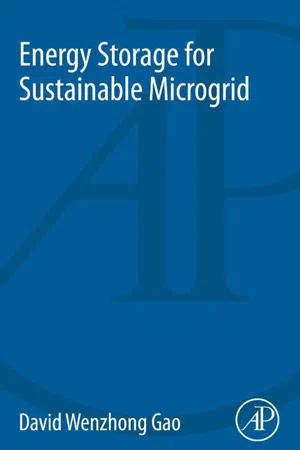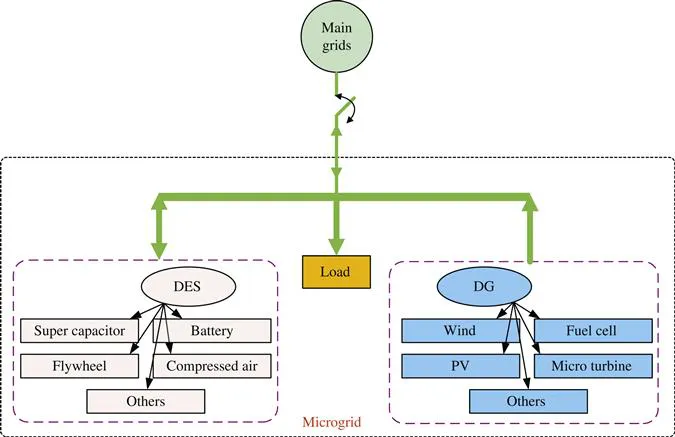
eBook - ePub
Energy Storage for Sustainable Microgrid
David Wenzhong Gao
This is a test
- 152 Seiten
- English
- ePUB (handyfreundlich)
- Über iOS und Android verfügbar
eBook - ePub
Energy Storage for Sustainable Microgrid
David Wenzhong Gao
Angaben zum Buch
Buchvorschau
Inhaltsverzeichnis
Quellenangaben
Über dieses Buch
Energy Storage for Sustainable Microgrid addresses theissues related to modelling, operation and control, steady-state and dynamic analysis of microgrids with ESS. This book discusses major electricity storage technologies in depth along with their efficiency, lifetime cycles, environmental benefits and capacity, so that readers can envisage which type of storage technology is best for a particular microgrid application. This book offers solutions to numerous difficulties such as choosing the right ESS for the particular microgrid application, proper sizing of ESS for microgrid, as well as design of ESS control systems for proper interfacing with the microgrid.
- Explanations for major power electronic converters/technology required to achieve the desired interfacing
- Case studies on the major impacts of energy storage on microgrid
- Detailed solutions for choosing the right ESS for particular microgrid applications
- Valuable economics chapter to help evaluate entire systems
Häufig gestellte Fragen
Wie kann ich mein Abo kündigen?
Gehe einfach zum Kontobereich in den Einstellungen und klicke auf „Abo kündigen“ – ganz einfach. Nachdem du gekündigt hast, bleibt deine Mitgliedschaft für den verbleibenden Abozeitraum, den du bereits bezahlt hast, aktiv. Mehr Informationen hier.
(Wie) Kann ich Bücher herunterladen?
Derzeit stehen all unsere auf Mobilgeräte reagierenden ePub-Bücher zum Download über die App zur Verfügung. Die meisten unserer PDFs stehen ebenfalls zum Download bereit; wir arbeiten daran, auch die übrigen PDFs zum Download anzubieten, bei denen dies aktuell noch nicht möglich ist. Weitere Informationen hier.
Welcher Unterschied besteht bei den Preisen zwischen den Aboplänen?
Mit beiden Aboplänen erhältst du vollen Zugang zur Bibliothek und allen Funktionen von Perlego. Die einzigen Unterschiede bestehen im Preis und dem Abozeitraum: Mit dem Jahresabo sparst du auf 12 Monate gerechnet im Vergleich zum Monatsabo rund 30 %.
Was ist Perlego?
Wir sind ein Online-Abodienst für Lehrbücher, bei dem du für weniger als den Preis eines einzelnen Buches pro Monat Zugang zu einer ganzen Online-Bibliothek erhältst. Mit über 1 Million Büchern zu über 1.000 verschiedenen Themen haben wir bestimmt alles, was du brauchst! Weitere Informationen hier.
Unterstützt Perlego Text-zu-Sprache?
Achte auf das Symbol zum Vorlesen in deinem nächsten Buch, um zu sehen, ob du es dir auch anhören kannst. Bei diesem Tool wird dir Text laut vorgelesen, wobei der Text beim Vorlesen auch grafisch hervorgehoben wird. Du kannst das Vorlesen jederzeit anhalten, beschleunigen und verlangsamen. Weitere Informationen hier.
Ist Energy Storage for Sustainable Microgrid als Online-PDF/ePub verfügbar?
Ja, du hast Zugang zu Energy Storage for Sustainable Microgrid von David Wenzhong Gao im PDF- und/oder ePub-Format sowie zu anderen beliebten Büchern aus Technologie et ingénierie & Ressources d'alimentation. Aus unserem Katalog stehen dir über 1 Million Bücher zur Verfügung.
Information
Chapter 1
Basic Concepts and Control Architecture of Microgrids
This chapter discusses the basic concepts and control structures of microgrids. Nowadays, distributed generation technology is becoming increasingly mature, and is deployed as active distribution networks working cooperatively with conventional power grids. In addition, the issues of exhaustible natural resources, fluctuating fossil fuel prices and the security of electricity have encouraged governments around the world to hold positive attitudes toward the development of emerging microgrids. Future microgrids will allow high renewable penetration and become building blocks of smart grids thanks to advanced communication and information technology. As the underlying scientific and engineering research questions are being answered, there is no doubt that microgrids will play an extremely important role in future electric power and energy systems.
Keywords
Centralized control; Control architectures; Decentralized control; Energy storage system; Microgrid concepts; Microgrid protection; Renewable energy resources; State estimation
1.1 Introduction
This chapter discusses the basic concepts and control structures of microgrids. Nowadays, distributed generation technology is becoming more and more mature, and is deployed as key elements of active distribution network working cooperatively with conventional power grids. In addition, the issues of exhaustible natural resources, fluctuating fossil fuel prices and security of electricity have encouraged governments around the world to hold positive attitudes toward the development of emerging microgrids. Future microgrids will allow high renewable penetration and become building blocks of smart grids thanks to advanced communication and information technology. As the underlying scientific and engineering research questions are being answered, there is no doubt that microgrids will play an extremely important role in future electric power and energy systems.
1.1.1 Concepts of Microgrids
Power generation in the traditional power grid is highly centralized, with power and energy flowing unidirectionally from large synchronous generators through a transmission/distribution network to end-users. However, the technological issues associated with traditional electric utilities, as well as the environmental problems caused by the combustion of fossil fuels, have stimulated research and development into new power system technologies. With the emergence of distributed energy resource (DER) units, e.g., wind, photovoltaic (PV), battery, biomass, micro-turbine, fuel cell, etc., microgrid technologies have attracted increasing attention as an effective means of integrating such DER units into power systems. However, there is no clear definition of a microgrid, and the concept varies in different countries and regions. Based on the European Technology Platform of Smart Grids [1], a microgrid is a platform that facilitates the integration of distributed generators (DG), energy storage systems (ESS) and loads to ensure that the power grid can supply sustainable, price-competitive and reliable electricity. Figure 1.1 shows a typical microgrid structure, comprising DGs, such as combined heat and power unit (CHP), microturbines, PV systems, wind power systems, fuel cells; a distributed energy storage (DES) facility such as battery banks, super-capacitors, flywheels, electric vehicles; flexible loads and control devices.

Microgrids can be classified as AC and DC types. AC microgrids can be integrated into existing AC power grid, but they require quite complicated control strategies for the synchronization process in order to preserve the stability of the system. On the other hand, DC microgrids have better short circuit protection and significantly improved efficiency. Furthermore, some synchronous units (e.g., diesel generators) and some non-synchronous units (e.g., micro-turbine machines) are usually connected in the same microgrid system. As the penetration level of more DC loads (especially Plug-in Hybrid Electric Vehicles) increases, hybrid AC/DC synchronous/non-synchronous microgrids via multiple bi-directional converters will become increasingly attractive. Figure 1.2 shows a typical system structure for a hybrid AC/DC microgrid that contains power electronic interfaces and multiple DER units.

Although many types of DG units are more sustainable, a high level penetration of renewable energy resources (e.g., wind, PV) in microgrids can make maintaining grid stability and delivering reliable power challenging due to intermittency and fluctuation issues. In such cases, a DES can play an essential role in improving stability, strengthening reliability, and ensuring security. Not only can DES units be used for smoothing the fluctuations from the output of DG units, but they ...